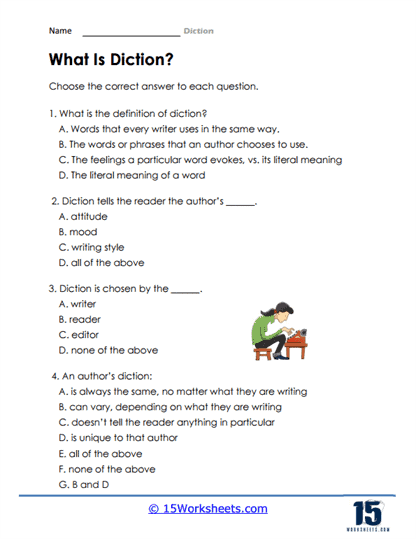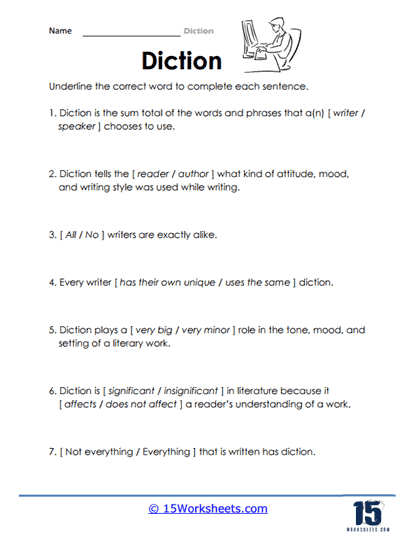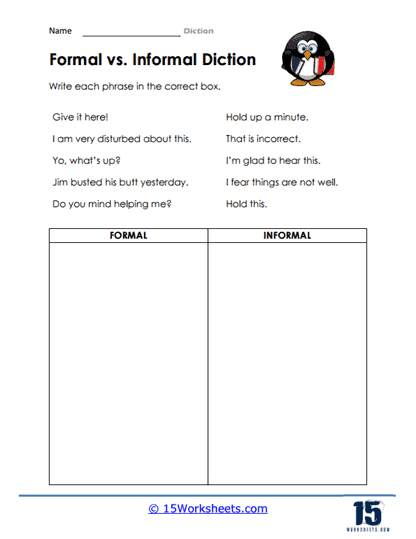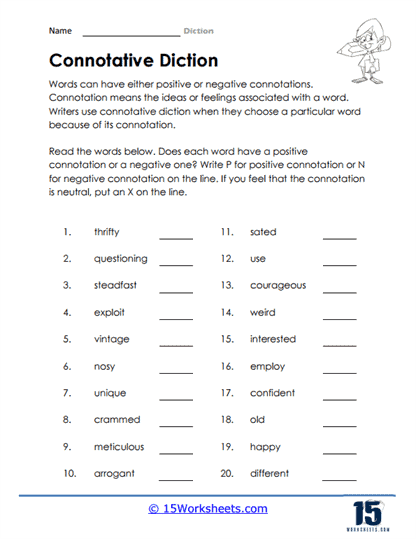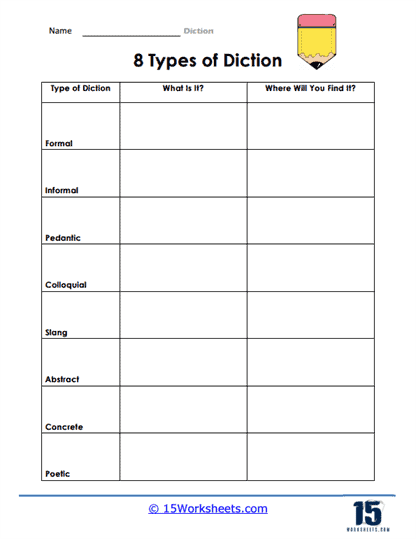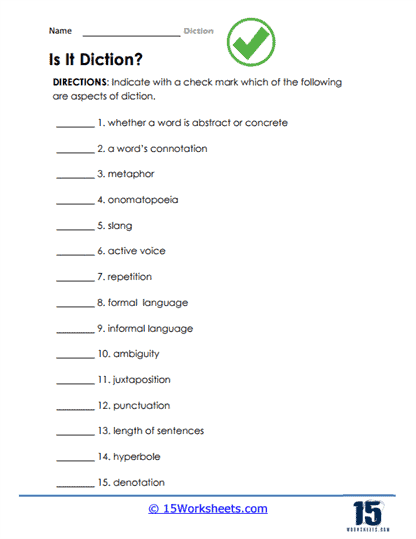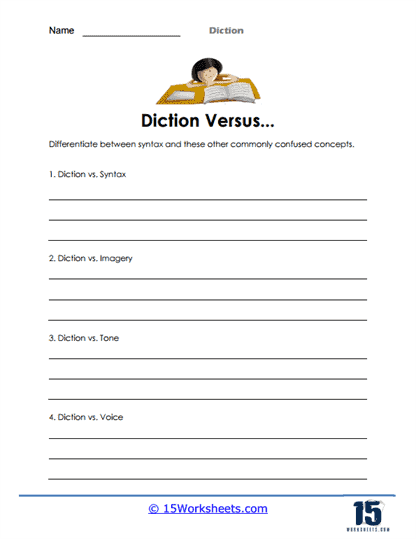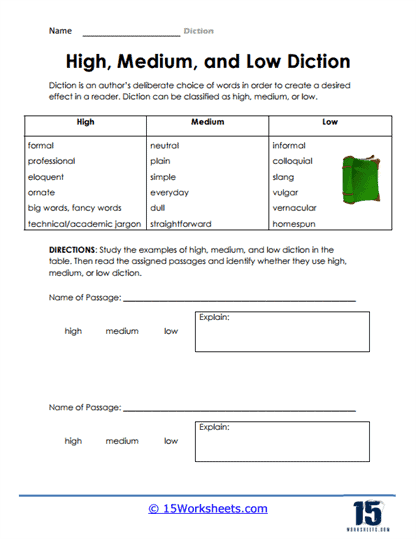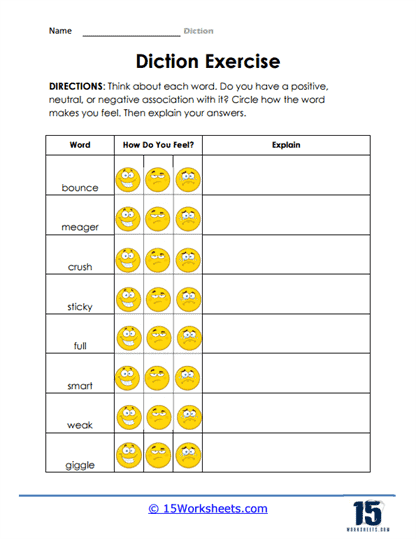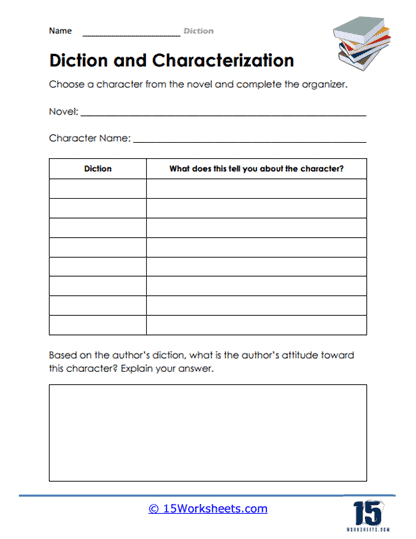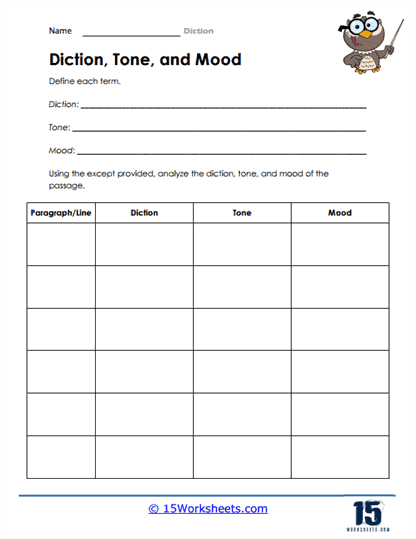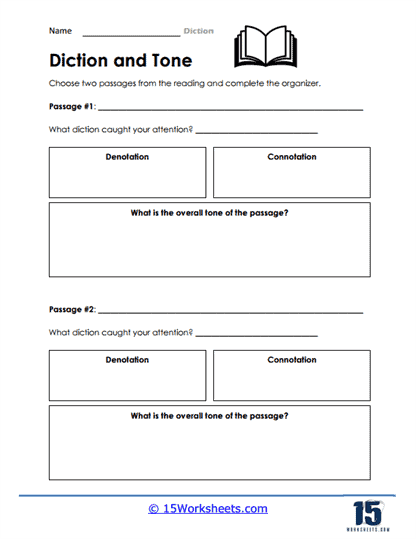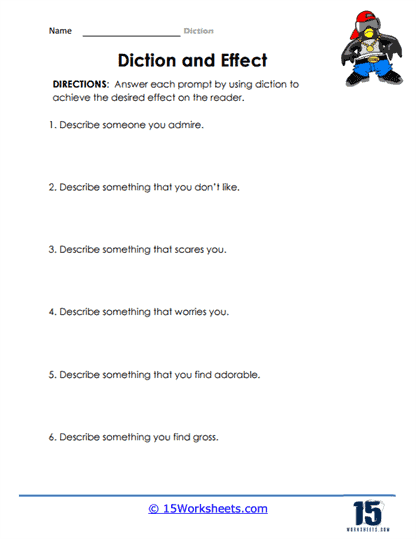Diction Worksheets
All About These 15 Worksheets
Diction, the careful choice and arrangement of words in communication, is a fundamental aspect of language that plays a crucial role in effective writing and communication. Understanding diction is not only important for mastering language precision but also for enhancing critical thinking, effective communication skills, and a deeper appreciation of the power of words. This collection of 15 worksheets is designed to introduce students to the world of diction, helping them grasp the importance of this linguistic technique, recognize its various forms, and develop their own language mastery.
What Are Diction Worksheets?
Diction worksheets were created to help students understand and practice the concept of “diction.” Diction refers to a writer’s choice of words and their arrangement in sentences. It greatly influences the style, tone, and mood of a piece of writing, and it can help to express the writer’s intentions and convey their message more effectively.
On these worksheets, students will encounter a variety of exercises designed to enhance their understanding of this concept and help them develop their own effective use of diction. Here are some examples:
Definition and Examples – An exercise might start with a basic definition of diction and some examples. This can help students understand what diction is and how it can vary.
Identification – Students might be given a series of sentences or passages and asked to identify the type of diction used. For example, is the diction formal or informal? Is it abstract or concrete? This helps students see how diction can change depending on context.
Analyzing – These exercises might involve longer passages. Students could be asked to identify the diction and analyze its effect on the tone, mood, or message of the text.
Rewrites – Students may be asked to rewrite sentences or passages using different types of diction. For instance, they might be asked to take a sentence written in formal diction and rewrite it using informal diction, or vice versa.
Comparing and Contrasting – In this exercise, students may be given two different texts and asked to compare and contrast the diction used in each. This can help students understand how different word choices can affect a reader’s perception and understanding of a text.
The purpose of these worksheets is to build students’ vocabulary and improve their writing skills. Understanding diction and being intentional about word choice can help students become more effective communicators and improve their ability to understand and analyze what they read. It can also enrich their creative writing, helping them to better express their ideas and evoke specific responses from their readers.
What is the Literary Device of Diction?
In the realm of literature, diction refers to the deliberate selection and usage of words by an author. It goes beyond mere word choice; it is the careful picking of words that will best convey the author’s intentions, evoke desired emotions, and shape the reader’s understanding. Diction plays a pivotal role in establishing tone, atmosphere, and characterization in a piece of writing. By choosing their words carefully, authors can paint vivid images, stir emotions, and subtly reveal their characters’ personalities and motivations.
Defining Feature of Diction
The main defining feature of diction is its ability to shape a reader’s perception and experience of a text. It determines the language style of a piece of writing, and it can range from formal to informal, abstract to concrete, plain to ornate, and colloquial to old-fashioned. The diction used by an author can tell us a lot about their intended audience, the setting and time period of the story, and the personalities of the characters.
Examples of Diction in Literature
Formal Diction in “Pride and Prejudice” by Jane Austen
Jane Austen’s classic novel “Pride and Prejudice” provides a perfect example of formal diction. Austen’s choice of sophisticated and precise language mirrors the manners and conventions of the English gentry in the early 19th century. Consider the opening sentence – “It is a truth universally acknowledged, that a single man in possession of a good fortune, must be in want of a wife.” The language is formal, sophisticated, and somewhat grandiose, reflecting the societal norms and expectations of the era.
Colloquial Diction in “The Catcher in the Rye” by J.D. Salinger
Salinger’s “The Catcher in the Rye” is renowned for its use of colloquial diction. The story is narrated in the first person by Holden Caulfield, a teenage boy, and his language is informal, conversational, and filled with slang, mirroring the way a teenager might speak. For instance, Holden often uses phrases like “if you want to know the truth” and “it killed me,” creating a distinct, authentic voice that allows readers to connect deeply with his character.
Concrete Diction in “Of Mice and Men” by John Steinbeck
Steinbeck’s “Of Mice and Men” employs concrete diction to create vivid imagery and deepen the reader’s engagement with the story. Steinbeck’s descriptions are filled with precise and sensory language, such as in the opening scene – “A few miles south of Soledad, the Salinas River drops in close to the hillside bank and runs deep and green.” The use of concrete diction here allows the reader to visualize the setting clearly, immersing them in the world of the story.
These examples illustrate how diction can shape a piece of literature. In each case, the author’s specific choice of words helps to create a particular tone, convey precise meaning, and provide insight into characters and settings. By being attentive to diction, readers can gain a deeper understanding of the text, while writers can more effectively communicate their ideas and evoke desired responses from their audience.
Benefits Of Diction Worksheets To Students
Exploring the world of diction through this collection of 15 worksheets offers students an opportunity to develop essential skills in language precision, literary analysis, effective communication, critical thinking, and cultural and historical understanding. Diction is a linguistic device that invites students to appreciate the intricacies of language use, the power of words, and the impact of word choice on meaning and interpretation.
By engaging with these exercises and activities, students not only enhance their academic abilities but also gain valuable tools for clear and persuasive communication, discerning literary analysis, and an understanding of how language reflects cultural and historical contexts. The benefits of studying diction extend far beyond the classroom, empowering students to be more effective communicators, thoughtful readers, and culturally aware individuals in an increasingly diverse and interconnected world.

